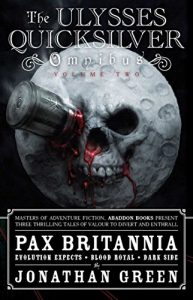The Ulysses Quicksilver Omnibus Volume Two, featuring three of Jonathan Green’s Pax Britannia stories has just been released.
 First of all for those not familiar with your Pax Britannia series can you tell us a bit about it?
First of all for those not familiar with your Pax Britannia series can you tell us a bit about it?
The Pax Britannia stories take place towards the end of an alternate 20th century in a world where the sun never set on the British Empire. Queen Victoria is still on the throne, kept alive by steam-power and clockwork, there are dinosaurs in London Zoo, robot Bobbies help police the crowded streets of the metropolis, people live under the sea as well as on the moon, Mars is trying to break away from the empire of Magna Britannia, while ne’er-do-wells plot the downfall of the status quo from within. The main protagonist of these stories in Ulysses Quicksilver, dandy, adventurer, and agent of the crown.
The Ulysses Quicksilver Omnibus Volume Two includes book 4, 5 and 6 in the series. Do you have any personal favourites among them?
I enjoyed writing all of them, for different reasons. Evolution Expects features my take on a steampunk Batman, which was a lot of fun to write, Blood Royal has vampires and werewolves, not to mention the return of the Ripper, and Dark Side finally sees Ulysses Quicksilver visit the Moon and encounter, among other things, giant robots and H G Well’s Selenites.
 What are your expectations now that The Ulysses Quicksilver Omnibus Volume Two has just been published?
What are your expectations now that The Ulysses Quicksilver Omnibus Volume Two has just been published?
Well I would hope that the book will introduce the series to a host of new readers and, in doing so, might lead to more Pax Britannia stories being published. After all, Ulysses’ story is not done yet and there are another two novels still to be collected.
Did you have the whole series mapped out when you started or did things develop as the books were written?
When I originally pitched the idea to Abaddon Books, I only had the world and the one story planned out. However, I knew I wanted to take Ulysses Quicksilver on a journey and that, in part, guided the development of the series. However, some stories came about purely because of what had happened in earlier Quicksilver adventures.
How do you feel you as a writer has developed throughout the series?
I think I’ve improved, becoming tighter at plotting and better at cutting out extraneous waffle and over-long sentences. I am certainly more confident about plotting a story arc that unfolds over numerous books! And I’ve become a more humorous writer too.
With the eight book in the series you started a bit of an experiment. Can you tell us a bit about that and how the response was?
There was going to be a bit of a delay between publishing number seven in the series, Anno Frankenstein, and number eight, Time’s Arrow, so I suggested that we bring out the first part of Time’s Arrow (sub-titled Red-Handed) as an eBook only, much earlier, and then let the readers vote as to how the story should continue.
Abaddon jumped at the chance. Once the votes were in I then wrote Part 2 – Black Swan – and the readership once again decided which way the story should turn next, and I culminated the experiment by writing the final part of the novel, White Noise. The whole was then collected and published in print form as originally intended.
The hardest part of the experiment was making it seem as if the novel had been written as one book right from the beginning.
What is it with Steampunk you find fascinating?
I love the Victorian aesthetic and the anachronistic nature of so much steampunk tech. I suppose childhood visits to the Natural History Museum in London, and Doctor Who on TV, had a bigger impact on me than I first realised!
You’ve also been involved in writing for Doctor Who. How did you get involved in this in the first place?
It happened when I went full-time as a writer back in 2007. Penguin Books had brought out a series of Choose Your Own Adventure-style Doctor Who books for children and being a life-long fan of the show, and an experienced author of gamebooks, I contacted their editorial department, offering my services.
It just so happened that I contacted them when they were preparing to commission another set of the books, and he editor was open to giving new writers a try. Having pitched them four ideas and sent in a writing sample, the Doctor Who production team in Cardiff whittled those four proposals down to two and the editor then asked me which one I would like to write the most.
As a result of that first adventure – The Horror of Howling Hill, published in 2008 and featuring the Tenth Doctor – I ended up writing an Eleventh Doctor novel for children, Terrible Lizards (which is being reprinted next year), and a Twelfth Doctor quiz book. In fact, I have another brand new Twelfth Doctor adventure gamebook coming out next year too, called Night of the Kraken. (It also led to me writing for Star Wars: The Clone Wars IP as well.)
Doctor Who: Terrible Lizards is to be released this year. Anything you can reveal?
The story was originally published along with another tale as part of Monstrous Missions (back in 2012) but is being re-released as a standalone title in 2016.
It is 1881, and something is lurking within the Florida Everglades, something from a land that time forgot. When the Doctor, Amy and Rory join a group of Victorian explorers searching for the legendary Fountain of Youth, little do they realise that neither their new companions, nor the treasure they seek, are quite what they seem.
You have also written for various other franchises. When you write in these universes, do you have a different approach compared to when you write in your own?
Not really. It’s more a case of getting the tone right and using appropriate vocabulary – in-world terms such as ‘perp’ for Judge Dredd, and ‘Cowabunga!’ for the Teenage Mutant Ninja Turtles.
How did you start writing? Was there a particular book or moment in your life that spurred you on?
I have wanted to be a writer for as long as I can remember. When I was six years-old I stapled bits of paper together to make little books, and a few years later I avoided doing any Maths at school and instead filled endless notebooks with stories (which were mainly terrible).
I suppose if there was one book that spurred me on to actively seek a career as a writer, I would have been the very first Fighting Fantasy adventure gamebook The Warlock of Firetop Mountain, by Steve Jackson and Ian Livingstone.
What kind of books do you read, any favourite authors?
I read lots of speculative fiction. Favourite authors include Terry Pratchett, Dan Abnett and Tim Powers, but I’m always discovering new favourites.
So what do you do when you’re not writing, any hobbies?
When I’m not writing I’m generally doing things with my family, which includes visiting the cinema to see the latest comic book-inspired blockbuster, going for long walks, exploring crumbling ruins, and playing an LEGO game available on the Xbox!
What’s next? Do you have more new and exciting projects you’re working on?
I’ve just published my 59th book – a new adventure gamebook called Alice’s Nightmare in Wonderland, inspired by Lewis Carroll’s original Alice books – and I currently putting together a new anthology of short stories called Shakespeare Vs Cthulhu, which blends The Bard’s most famous plays with H P Lovecraft’s most squamous creations. (We are currently seeking funding on Kickstarter)
In the New Year I’m going to be writing a novelisation of an unproduced feature-length episode of the 1980s TV fantasy series Robin of Sherwood, called The Knights of the Apocalypse, and I will also be reimagining another classic of children’s literature as an adventure gamebook, in this case The Wizard of Oz.
* * * * * * *
Interview by Dag Rambraut – SFFWorld.com © 2016




